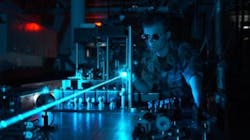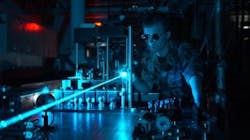Laser surface treatment project receives €3.5M in funding
Enschede, Netherlands - The University of Twente is receiving an EU grant for a Marie Sklodowska-Curie project titled Laser4Fun involving laser surface treatment. The researchers are becoming increasingly successful in adding a particular function to an existing surface with lasers, resulting, for example, in bacteria-free medical equipment in hospitals or water and oil repellent products in the packaging industry.
Gert-Willem Römer, a laser researcher at the University of Twente, works with ultrafast lasers—picoseconds or even femtoseconds. "The major advantage of such an extremely short laser pulse is that there is almost no thermal response from the material that is being processed. The material therefore does not melt, but is, as it were, removed 'cold', since chemical bonds are broken. As a result, it is as though atoms 'break' from the material, rather than melting, vaporizing, and blowing away," he says.
Using the latest laser techniques, many surfaces of existing products can be accurately treated. The technique can replace the special coatings that are currently applied to existing materials for surface improvement.
"Keeping surfaces free from bacteria is an important application," Römer says. "For example, you do not want bacteria to flourish on medical instruments in operating theatres. The food industry can also benefit from, for example, bacteria-free food processing equipment. With the laser-machined surfaces, it is possible to prevent cells from adhering strongly to the surface or to ensure that they do adhere. Water or oil-repellent products are another important application. An example includes a ketchup bottle from which you want to extract the very last drop and do not want any remains to stick to the inside of the bottle. A cleaner, completely empty bottle is also much more environmentally friendly when recycling."
Micromachining with short pulse lasers has major advantages over photolithography, a technique used for making chips. “Photolithographic techniques are optimized mainly for processing silicon, the base material from which chips are made," Römer explains. "With a short-pulsed laser, however, almost any material can be treated. Metals, polymers, glass, semiconductors—you can process virtually anything with lasers. In addition, in contrast with lithography, the machining with the laser can be performed in normal environmental conditions. Laser processing is thus more easily accessible and much cheaper in comparison. Micromachining with lasers is especially interesting for operations on a scale of between 100nm and 100µm.”
The biggest challenge in the project is to realize a higher laser processing speed. To apply the latest techniques further on an industrial scale, scaling-up is required. "We are working on a laser technique called Direct Laser Interference Patterning (DLIP) where multiple laser beams are combined to create an interference pattern of multiple 'laser spots'. This enables us to perform the operation much faster than with one single laser spot. We are also working in the project on hybrid technologies in which we combine the laser treatment with other techniques. You can, for example, first treat the material with a laser and then, with an etchant, remove the material that has been modified with the laser," Römer says.
Laser4Fun is receiving a European Marie Curie “European Training Network” grant of 3.5 million euros ($3.9 million). From the grant, as many as 14 Early Stage Researchers will be recruited for research positions in the frame of a PhD doctoral program, targeting a PhD degree. This European Training Network involves joint research training of the PhD candidates at 10 partners from in and outside academia. The aim is for the researcher to experience different sectors and develop their transferable skills by working on this research project. Academic partners participating in the project are the Fraunhofer Institute for Material and Beam Technology (IWS), the Technical University of Madrid, CNR in Italy, the University of Birmingham, and the Leibniz-Institut für Polymerforschung. Industrial partners in the project are BSH group, Alphanov, Robert Bosch, and Airbus. The project, which started September 1, 2015, will run for four years.
For more information, please visit www.laser4fun.eu.

